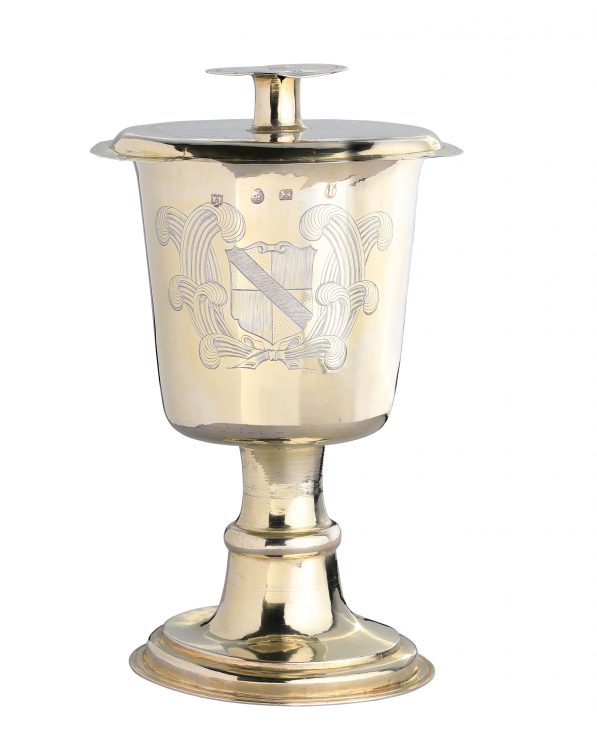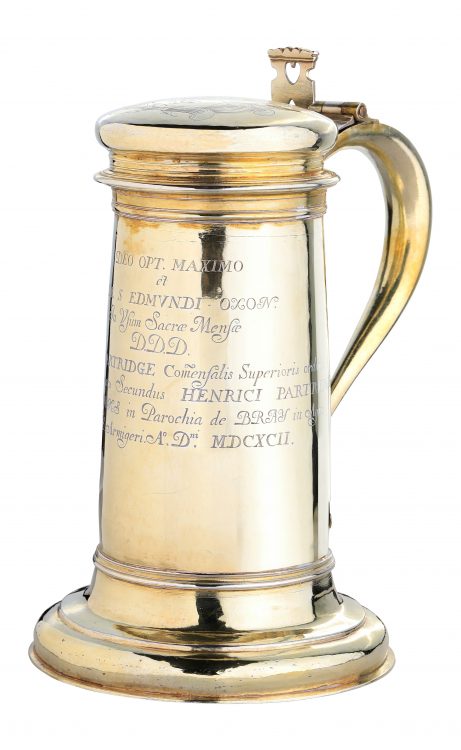A History of Teddy Hall Silver
29 Jan 2020|Jonathan Yates
- Library, Arts & Archives
During John Mill’s principalship, students were encouraged to leave to the Hall either a book for the library or an item of silver. In the period around 1700 our Benefactors’ Book records 11 donations of silver tankards. However, the current inventory lists only a single tankard from this period. What happened to the other ten?
Thomas Tullie first started the practice of undergraduates leaving silver to the Hall. From 1658 to 1665 we have records of donations of more than 30 silver items – typically, cups and tankards. These served a practical purpose and were intended for everyday usage. Tullie wrote an extensive list of regulations covering the use of the college silver. At meals in Hall the senior students could use one or two silver items. Once these were distributed, the more junior students could use pewter items, and the most junior students, earthenware. Senior students were also permitted to borrow silver for use in their rooms, if visited by “strangers of qualitie”. Harsh punishment was in store for any student who “injured ye plate”.
Owning silver was also a means for an institution to hold wealth because, prior to the 19th century, the value of silver objects lay almost entirely in the cost of the metal itself. Such was the intrinsic value of silver that items could simply be melted down and sold when funds were scarce. This happened to the Hall’s silver in 1679 when the next principal, Stephen Penton, sold almost all of the Hall’s silver to finance the building of the Chapel and Old Library.
Donations of silver began again under Penton’s successor, John Mill. Some of the first gifts were for use in the Hall’s new chapel. In 1688 James Clavering (matric. 1687) of Axwell in Nothumberland gave a chalice and paten. Four years later a large communion flagon was given by Henry Partridge (matric. 1688) of Bray in Berkshire. Both pieces are made from silver-gilt, i.e. silver coated in a thin layer of gold. In 1701 three former students, including White Kennett, later Bishop of Peterborough (matric. 1678), gave a fine two handled cup in celebration of their being awarded Doctor of Divinity degrees. All of these pieces are still in the Hall’s possession; however, of the 11 tankards given at this time, only John Bennett’s survives (matric. 1701).


After Mill died in 1707 the practice of donating silver all but stopped, with only a single donation under the following two principals. When Thomas Shaw became Principal in 1740 he appears to have found the Hall in poor condition. Because the buildings had been neglected, he spent a large amount of his own money on re-building. He also made an inventory of the college silver. And it is from this list – and the lists made by each subsequent Principal – that we find the answer to the mystery of the missing tankards.
The inventory completed in 1751 at the end of Shaw’s principalship notes, “Two salvers, late Mr Pelham’s Tankard” and “Two sauce boats, late Gomeldon’s Tankard”. On assuming the principalship, Thomas Shaw sent some of the eleven tankards to be melted down and exchanged for new, more useful items, probably because the tankards had become worn or damaged. In each case the new pieces were engraved with the details of the original gift. Over the next century all save John Bennett’s tankard were exchanged for newer pieces. In some cases several exchanges were made. For example, the tankards from Mr Cook and Richard Newdegate (matric. 1697) were first recast as a decantor, before becoming a pair of candlesticks still used regularly for dinners. Happily, all of the silver given during John Mill’s principalship survives. In many cases the objects have changed form, but the gifts and the names of the student donors live on in the Hall’s silver collection.

Observant readers will note that I wrote that almost all of the college silver was melted down in 1679. So, what survives from Thomas Tullie’s silver? In 1666 John Gell (matric. 1666) gave the Hall a set of spoons, and in 1740 Thomas Shaw recorded these “six spoons, three of which are whole, and three broken”. He exchanged them for 3 forks and a very well made marrow scoop. All are still in our possession over 350 years since John Gell’s original gift.
Category: Library, Arts & Archives
Author

Jonathan
Yates
Professor Jonathan Yates is a tutor in Materials Science at St Edmund Hall. He also holds the role of Picture and Chattels Fellow which sees him take responsibility for the cataloguing, conservation and use of the Hall’s art collection, including paintings, photographs, silver and other items.